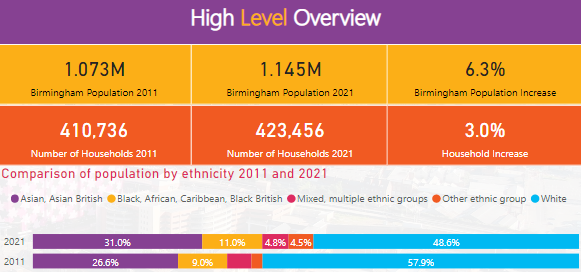
Analysis of Census 2021 Data

It is almost a month since the launch of the Birmingham City Observatory, and we are now releasing our first new set of data and insights into the Observatory from the 2021 National Census. The Census is a treasure trove of information that can help inform decision making and build a better understanding of our city and region.
We have created a Birmingham Census Dashboard, which allows you to explore and visualise the data in multiple ways, to see what is changing over time, and to compare us to other places including the other core cities and our West Midlands neighbours. Over the course of 2023 more and more information will be released from the Census, and we will build up our analysis and work with partners to generate insight from the data.
The dashboard is available here: Census 2021
We have also published a short topic briefing on ethnicity and religion here: Census 2021 Ethnicity and Religion Analysis
Some of my highlights:
- You will have seen the news that Birmingham is now a superdiverse city, with 51% of the population being from Black, Asian or other minority ethnic groups. When you compare ethnicity across the core cites, Birmingham’s not only has by far the largest Black, Asian and Minority Ethnic population (51%), but also stands out along with Manchester (43%) and Nottingham (34%) in contrast to the other core cities which still have a large majority White populations. (See page 2 of the dashboard to explore and download the data.)
- When you compare ethnicity across the West Midlands Combined Authority Area, you can see a high level of diversity across much of the region: Sandwell has the same level of diversity as Manchester (43% Black, Asian and Minority Ethnic pop.) and Wolverhampton is close behind (39%).
- Birmingham is the ‘most religious’ of all the core cities with 66% of the population professing a religion. The Muslim group in Birmingham is by far the largest of any core city and is now almost the same size (30%) as the Christian group (34%). Liverpool stands out as being particularly Christian (57%).
- At the regional level, our Sikh population stands out: 3% of Birmingham’s population are of this community, and the figure is 11% for neighbouring Sandwell and 12% for Wolverhampton. If you look at the maps on page 4 of the dashboard, select ‘output area’ and click on a religion or language, you can see in detail where different communities are concentrated. This is important data for many partners planning services, facilities and public engagement.
- Birmingham’s overall population has grown from 1.07 to 1.14 million people. However, there has been a fall in the population aged 0-4 years, and the largest growth is in the older age categories. (Page 3 of the dashboard gives you the exact numbers). We are also becoming more densely populated per dwelling: the number of people has increased by 6% but the number of households by only 3%.
- Check out page 5 of the dashboard for detailed information on how people usually travel to work and how far they go (although do note that lockdown measures will have affected answers on this topic). If you select ‘output area’ you can see in fine detail which parts of the city work from home, use trains, and get on their bicycles. At the time of the 2021 Census, the number of people working mainly from home had jumped up to 26%, and the biggest compensating fall has been in the number driving a car or van.
As usual, the dashboard is a work in progress, and we want your feedback. What functionality is most important to you? What doesn’t work well, what is missing, or wrong, or in your view misleading? What issues and topics would you like to see addressed? And most importantly, what can we do together to enrich and improve the data and make it more valuable and insightful for all of us?
Please join us on this journey to make the City Observatory a valued and shared resource. We are happy to come and discuss, demonstrate, develop and explore with you. Finally, from myself and all the team at the Birmingham City Observatory, we wish you a peaceful break over Xmas, and a successful and curious new year.
Author: Richard Brooks

Our Launch Event
On Tuesday 22nd November 2022, we proudly launched our Birmingham City Observatory. With thanks to Arcadis our local sponsor, the event took place in Birmingham’s tallest office building, 103 Colmore Row, which provided a backdrop to the stunning views of the city and beyond.

 Developing the Birmingham Data Charter
Developing the Birmingham Data Charter


